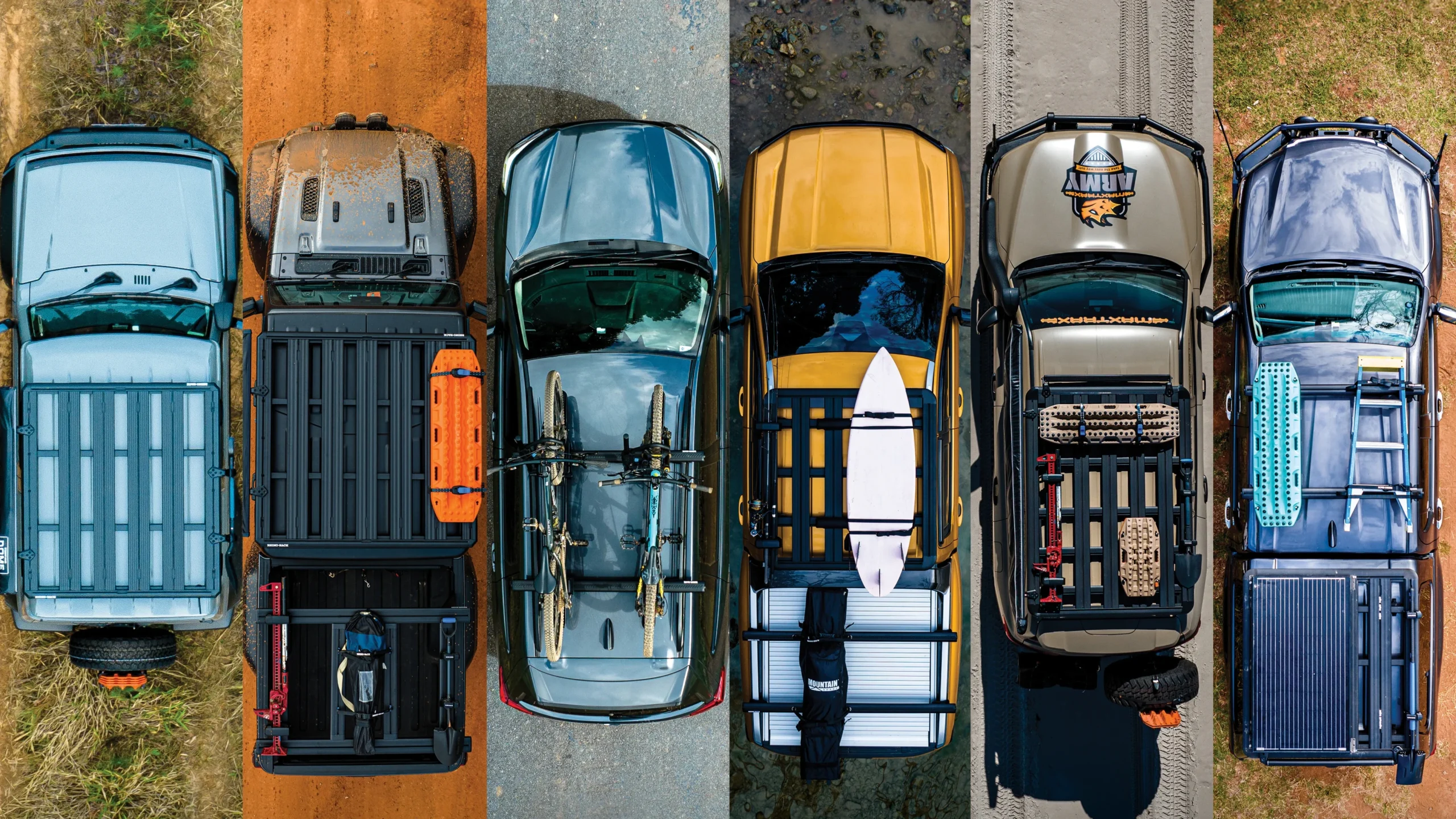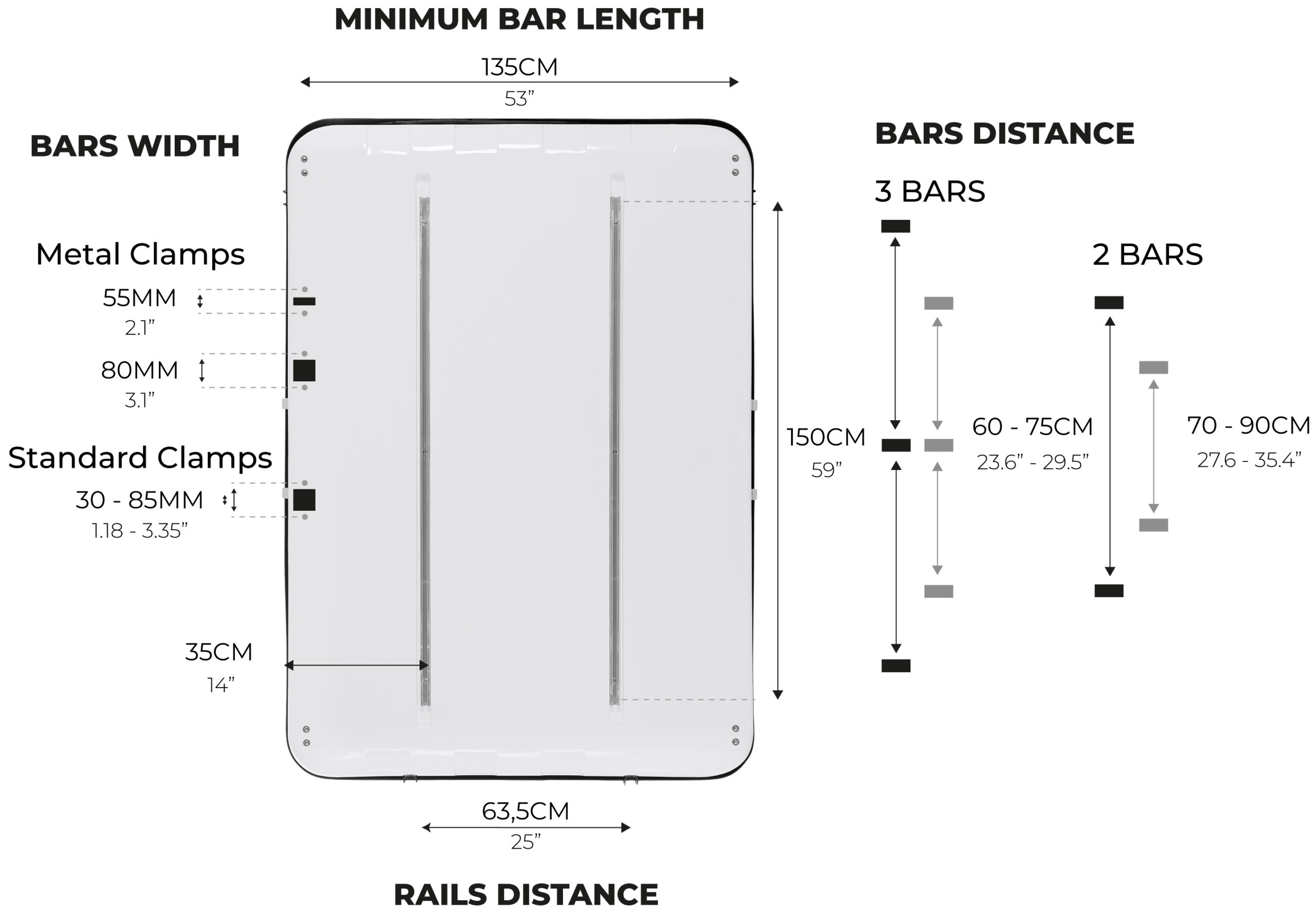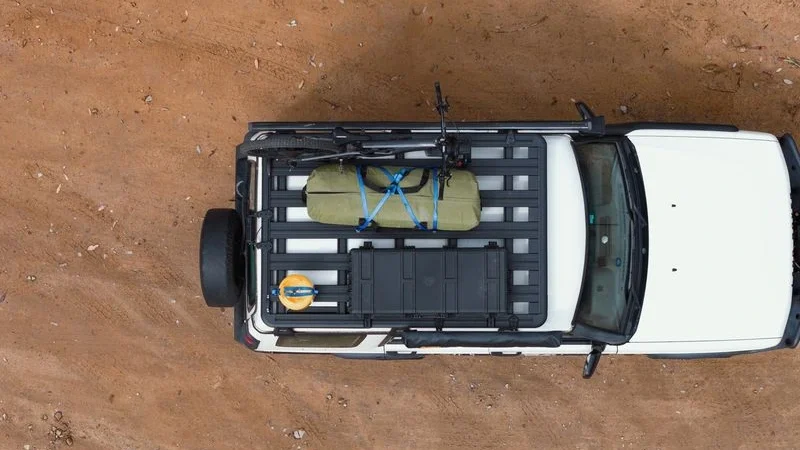
What roof rack to use for your rooftop tent?
19 Nov, 2024
With the global growth of overlanding and rooftop tents, we’ve seen more variations of roof racks hit the market. Sometimes selecting the right mounting system for your tent and gear is more complicated than the rooftop tent itself! Below, we aim to provide some guidance on the differences and trade-offs of rack selection and offer a few tips on what to look out for.
There are three main types of roof rack systems to consider for mounting a rooftop tent: crossbars, platforms, and pickup bed racks.
Jumping straight into purchasing a rack without considering the crucial factor of weight limits can lead to dangerous situations on the road or costly mistakes. To avoid these pitfalls, let’s explore this topic before you choose your roof rack.
Roof Rack Weight Load Limit
– Static vs. Dynamic
The roof of your vehicle has two weight limits to consider: static and dynamic.
The static weight is the maximum amount the roof can safely hold when the vehicle is parked. This includes the weight of everything on your roof, including a rooftop tent, occupants inside the tent, and any gear you’ve stored.
For static weight, add the combined weight of the people who will be inside the tent, plus the tent itself and any additional gear mounted on top.
Did you know?
Most car companies do not test for the static load limit with different accessories such as roof top tents. However, vehicle roofs on nonconvertible vehicles are designed so that the roof does not collapse in the event the vehicle rolls over, or is under pressure from elements like snow. The difference between those loads and the ones mounting accessories on a roof rack is the weight distribution.
If snow falls on the roof of a car, the weight is perfectly distributed along the entire roof. If the weight is over a roof rack that are mounted over 4 legs. The weight is distributed only over the mounting points of those 4 legs. Adding support points improves the weight distribution.
Dynamic weight, on the other hand, refers to the maximum weight your roof can handle when the vehicle is in motion. Dynamic weight capacity is significantly lower than static capacity. This is because driving introduces additional forces like acceleration, deceleration, turning, and wind resistance. These forces put extra stress on the roof, effectively increasing the load compared to when the vehicle is parked.
Dynamic weight is calculated similarly to static weight, but without the weight of the people (as we do not recommend being inside the tent when the vehicle is moving).
The following table provides these specifications for some commonly used SUVs. These are taken from the owner’s manuals yet keep in mind those can change for different sub models, for example there is a 100 lbs difference between the 4Runner 2004 and the 2020. It’s essential to verify the exact limits in your vehicle’s owner’s manual.
You will notice that the dynamic load capacity is far lower than the static load. But as you can see in the real world, there are thousands of SUVs like the 4Runner with rooftop tents and the roofs are not collapsing.
| Vehicle Model | Dynamic Load Capacity | *Estimated Static Load Capacity | Source |
|---|---|---|---|
| Toyota 4runner | 120 lbs | *360 lbs | Toyota 4runner 2024 – user manual page 280 |
| Toyota RAV4 | 176 lbs | *528 lbs | RAV4 2024 user manual page 188 |
| Toyota Sequoia | 154 lbs | *462 lbs | Sequoia 2024 user manual page 197 |
| Toyota Land Cruiser | 165 lbs | *495 lbs | Land Cruiser 2024 user manual page 209 |
| Jeep Wrangler | 150 lbs | *450 lbs | Wrangler 2024 Manual page |
| Jeep Grand Cherokee | 150 lbs | *450 lbs | Grand Cherokee – user manual – page 100 |
| Subaru Outback | 220 lbs | 700 lbs (official) | Outback 2024 user manual – page 467 |
| Subaru Crosstrek | 176 lbs | 700 lbs (official) | Crosstrek 2024 user manual – page 411 |
| Rivian R1S | 250 lbs | 780 lbs (official) | R1S 2024 user manual – page 388 |
| Chevrolet Tahoe | 220 lbs | *660 lbs | Tahoe 2024 user manual – page 98 |
| Ford Explorer | 165 lbs | 661 lbs (official) | Explorer 2024 online user manual |
Manufacturers test the worst-case scenarios within a defined scope. Their testing parameters are chosen to ensure safety, but don’t represent the full range of possible situations a vehicle might encounter. For example, they test to ensure safety in a scenario with a car with a roof mounted accessory doing an abrupt braking while going downhill off road at high speed. Compare what the stress on the roof would be in the scenario of driving on paved roads, at a reasonable speed braking with caution. The roof can take the extra load as long as the operator exercises common sense when carrying a heavy load.
Remember
The crossbars and the roof itself have separate weight limits that must be considered. The roof rack system will likely fail before the roof of your vehicle, therefore it might be better to focus on the weight limit of the rack. Reputable rack manufacturers have specific testing methods to find the weak points on their rack system testing with different accessories and weight distribution.
Crossbars
In our experience, a basic crossbar system is still the most popular and simple way to mount a rooftop tent. The concept is straightforward, a minimum of two bar holders that are affixed to the top of the vehicle, one on each side, and the crossbar usually gets clamped or fastened into the base. Many vehicles come with factory bars pre-mounted and if not, most have tracks or rails that allow aftermarket crossbars to be installed. Some passenger cars don’t come with tracks or rails, and in these cases, there are options such as professional installation where universal mounts are drilled into the roof or sides of the vehicle. There are other innovative ways to mount racks to roofs such as vacuum cup mounting systems.
Most rooftop tents require either two or three crossbars for secure mounting, some even utilize four. Two crossbars provide base suitable for most small tents. Three crossbars offer improved stability and weight distribution, which is crucial for larger tents with heavier loads and may be a requirement for some tent designs. The addition of a middle crossbar helps distribute the weight more evenly across the vehicle’s roof and provides essential support to the tent base.
How many crossbars – The tent is secured to the racks to using aluminum channels that go from front to back of the tent. Those channels are made of aluminum as they will have the strength required, it is light weight and does not rust. However, it is also flexible to some extent. Two bars that are centered and properly spaced out will give proper support. If those bars are too close together or are not centered, the end of the tent can freely bend, especially driving at high speed. If the separation of the 2 bars is greater than recommended, the center of the tent can bend. The way to solve this is to add 1 or 2 more crossbars as required for additional support.
Crossbar load – every aftermarket crossbar system will list its weight load on the specs sheet. However, it’s not always easy to locate the same information for bars or rails that come preinstalled with a vehicle. It’s important to contact the manufacturer or dealer for this information because it is common to for preinstalled bars to be designed for lighter weight items such as skis, bikes and storage boxes. In most cases these bars would not support a rooftop tent. We recommend Heavy Duty (HD) bars and base for all James Baroud rooftop tents. This is not where you want to compromise.
Crossbar spacing – every rooftop tent has requirements on the spacing distance between each crossbar and sometimes. The spacing range for James Baroud rooftop tents is between 70 CM to 95 CM.

Crossbar length – the minimum crossbar length for all James Baroud rooftop tents is 53.15 inches (135 CM). The width of the tents ranges from 51.5 inches to 63 inches (130 CM to 160 CM) therefore 53.15 inches (135 CM) will be slightly larger than the smallest tent, and shorter than the width for the largest tent. It is important to bear in mind that if you intend to mount an awning or other accessories that sit next to the tent, then it’s likely longer bars that protrude from the tent will be required.

Platforms
Platforms are very useful to accommodate several accessories of different sizes and shapes that would be difficult to mount onto a 2 or 3 bar system such as jerry cans, toolboxes, propane tank, chairs, water tanks. For rooftop tents, as we established before, 2 or 3 crossbars are sufficient to mount a tent. But there are a few advantages, and tradeoffs, on going the extra mile of getting a full platform.
The tent covers the platform leaving very minimum usable space of the platform for other accessories. Platforms are heavier than crossbars. The additional weight high over the car raises the center of gravity of the vehicle making it more unstable. They are also more expensive, essentially paying for material that is unusable. However, if the vehicle does not allow proper crossbar spacing or if the tent will be removed from time to time to use the platform for other purposes, then the platform might be the only or best option.
Platforms are typically a grid of bars surrounded by a frame that provides more stability to rooftop tents because there are more touchpoints and rigidity than crossbars. These systems have grown in popularity as some OEMs are preinstalling them on 4X4 off road vehicles or working with rack manufactures to produce custom fit platforms for a vehicle.
When it comes to mounting a James Baroud rooftop tent on a platform there are four things to consider:
Pickup Bed Rack Systems
Over the last 2 years the number of manufacturers producing pickup bed racks has exploded. The principles behind how these structures work are similar. There’s usually a clamp or bracket that attaches to the side walls of the bed box, one in front of the rear wheel well and the other behind it. There are vertical bars or panels that extend upwards followed by two or more bars that connect on top across the bed.
When choosing a bed rack for a James Baroud rooftop tent there are a few things to consider:
The most popular options like the Yakima OutPost HD, Yakima OverHaul HD, Leitner ACS, Prinsu, Trucked, and Tuwa Pro offer varying capacities and price ranges to suit different needs. Load capacities typically range from 300 lbs off-road to over 1,000 lbs on-road, making them ideal for hauling rooftop tents, gear, or other heavy equipment. Prices vary significantly depending on the brand and features, with Yakima racks starting around $899 and Leitner systems reaching up to $2,000.
Final Thoughts
This summary of the different roof racks mounting systems is a high-level explanation of how they work and some things to watch out for when thinking ahead to the James Baroud products you may want to use.
For Jeep owners, we’ve put together a comprehensive guide that covers everything from roof rack selection and tent compatibility to essential tips for a seamless overlanding experience in your Jeep: 6 Jeep tent considerations for overlanding and camping
We hope you found it useful and if you have additional questions please don’t hesitate to reach out, we are always here to help.
Roof Rack Questions?
Our team has helped thousands of James Baroud customers with their installation and are ready to meet with you to answer any questions about your specific setup, weight limit, crossbar spacing, and tent compatibility.
